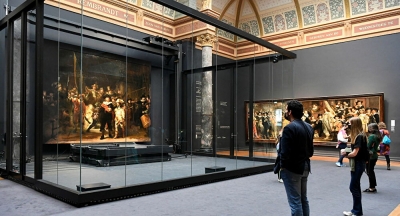
One of the most famous artworks in the world, the “Night Watch” by Rembrandt has captured the imagination of people for centuries. And now, for the first time in 300 years, the painting has been displayed in its full size with the help of artificial intelligence.
What is the Night Watch?
Painted by Rembrandt in 1642, the “Night Watch” depicts an Amsterdam captain ordering his men into action. It is famous for its enormous size of 363 cm x 437 cm. Years after its creation, the painting had to be trimmed in 1715 on all four sides, when it was moved from Kloveniersdoelen, the headquarters of the Kloveniers militia, to the Town Hall of Amsterdam. In order to fit its new location between two marble columns, this painting was cut two feet from the top, two feet from the left, and inches from the right and the bottom, which drastically altered its appearance and effect.
We know what the original painting looked like because of copies made at the time. Although the original strips have not been found, recently researchers were able to restore the painting to its original size by recreating the missing parts with the help of Al.
New discoveries
The painting has been displayed temporarily at an exhibition at the Amsterdam museum. Expanding the photo to its original dimensions has given researchers and viewers insights into the masterpiece. For instance, Captain Frans Bannik Cocq, the central figure in the painting, now appears to be a little off centre, as Rembrandt had originally intended. This changes the tone of the picture, as the militia led by Cocq now appears to be marching towards their destination.
The restoration has also brought to light some figures that had been cut out of the original. These include three onlookers on a bridge, two militia and a young boy. Also, a boy in the left foreground can now be clearly seen running away from the militia. The figure of a drummer entering the frame from the right side has also been restored. The drummer now confidently marches onto the scene, prompting a dog to bark.
How it was restored
First, both “The Night Watch” and the much smaller copy by Gerrit Lundens produced around 1655, had to be carefully photographed. Then researchers scaled the images to the original size, and the Al made repeated attempts at replicating Rembrandt’s style and colours closely and restoring the painting.
Technology in Art
In April, 2021, a team of engineers created a 3D printed copy of Michelangelo’s sculptural masterpiece “David”. The iconic 17-foot copy, as tall as the original, which stands in Florence’s Galleria dell’Accademia, is the most faithful replica of the statue ever made.
Did you know?
- The painting was originally called “Militia Company of District II under the Command of Captain Frans Bannick Cocq”, but it got its nickname, “The Night Watch” because the multiple layers of varnish applied to the painting had darkened it to such an extent that it gave an incorrect impression of a night scene. The varnish was removed in the 1940s, but the nickname remains.
- Despite his fame as an artist, Rembrandt descended into abject poverty in the latter half of his life. There are several conspiracy theories that “The Night Watch” led to his downfall. One of the theories dramatically proposes that the painting holds clues to a murder conspiracy. However, scholars dismiss such theories.
Picture Credit : Google




